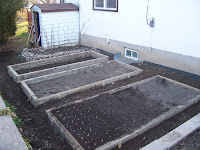Now I am not sure when, how, or why it happened, but over the course of the last 50 or so years, it suddenly was no longer as culturally-acceptable to have such gardens in an urban settings (especially when said gardens were easily visible!). I have heard many stories of neighbours complaining, fights with landlords/bylaw officers, all in the struggle to maintain a more sustainable home (and not just with gardens, but to raise chicken/other small animals for food, wind turbines; even Toronto has a rediculous
 by-law against hanging clotheslines!), but this article posted by one of my friends on facebook really takes the cake. The article tells of a group of housemates in Vancouver who decided to use the space in their front yard to grow a "permiculture" vegetable garden (not usings straight, orderly rows, but a more random, organic layout). Apparently, after a couple of complaints from neighbours the city has ordered them to "clean up" their yard, or face hefty fines.
by-law against hanging clotheslines!), but this article posted by one of my friends on facebook really takes the cake. The article tells of a group of housemates in Vancouver who decided to use the space in their front yard to grow a "permiculture" vegetable garden (not usings straight, orderly rows, but a more random, organic layout). Apparently, after a couple of complaints from neighbours the city has ordered them to "clean up" their yard, or face hefty fines.My first thought after reading it, and looking at the picture provided was "that doesn't look ugly or untidy at all!" Mind you when it comes to gardens I do like the more natural, rustic appearance as opposed to a perfecly manicured one, but even still; I think that the city's ruling was a little too severe. I am curious to see how this pans out.
I am sure this is not the only case of it's kind. I want to know when the "look" of a garden was more important than it's substance (I suppose I can understand if they had old cars and trash littering the yard, but this was not only a garden, but one that was tended!). Urban centres, and society in general has reached a point when we can no longer afford to uphold such laws and by-laws that prohibit individuals and families from living sustainably. Now this is a tough thing to say, because granted, we cannot let ourselves submit to anarchy in the name of living as environmentally friendly as possible, but there has to be some give.
And granted, not everyone has the option of having their own garden, or putting up wind turbines/solar panels etc. But there are things that can be done. In Penetang, a group has just re-opened the community garden to the public after years of disuse. Individuals/families can now apply to rent a plot for the year (I do not believe there is a fee involved), and have it to grow vegetables/flowers as they see fit. It is a wonderful opportunity for anyone wanting to start a garden, but has no land themselves (such as apartment/condo dwellers). I know for years (not sure if it is still there) there was a large development of this kind down in Ash Bridges Bay i
 n Toronto, as well as elsewhere in the city.
n Toronto, as well as elsewhere in the city.Another option is container gardening. My sister-in-law just introduced me to the book Crops In Pots; which has some fantastic ideas for beautiful arrangements in planters, all of them edible. (And for each container "recipe," there is an actually recipe that uses all the vegetables/fruits planted in the pot!) I was actually quite surprised to find out how many fruits and vegetables thrived in container gardening, even things like corn, miniature apple trees and grape vines that I would have never suspected. A fantastic book!
Luckily though, it seems like it was mostly the larger cities and urban centres that fell prey to the mentality that urban homesteading is unnapealing. One only has to stroll through the backyards (and sideyards, and frontyards!) of Penetanguishene during the summer months to see that urban vegetable gardening is alive and well. It is not uncommon to have the majority of your backyard dedicated to your garden, and as I have learned from various family members of Chris', this has always been the case. However, what has changed is that it is no longer just the older generations participating in these ventures. Younger couples and families have since seen the benefits of growing their own food, and the awareness is increasing.
And that is in part what I hope this blog will accomplish: awareness, if nothing else.





 After months of waiting, planning, and painting (to which Lucien's room is STILL not finished!), our new son has finally arrived!
After months of waiting, planning, and painting (to which Lucien's room is STILL not finished!), our new son has finally arrived! Another bonus to having Chris home is that rapid headway is being made on the side yard and gardens. One bed is completely in (it was my surprise present!), and the other two have been framed out. We just need to order about 3 cubic yards of topsoil to flesh out the beds and a truckload of wood chips for the walkways, and we'll be ready to plant! I even had
Another bonus to having Chris home is that rapid headway is being made on the side yard and gardens. One bed is completely in (it was my surprise present!), and the other two have been framed out. We just need to order about 3 cubic yards of topsoil to flesh out the beds and a truckload of wood chips for the walkways, and we'll be ready to plant! I even had


